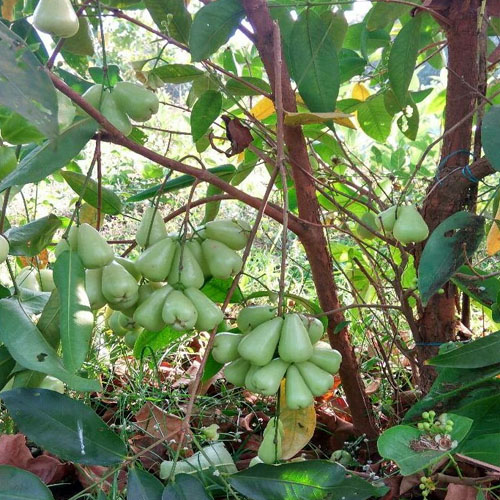Water Fruits Plants
Water fruits generally refer to fruits that are high in water content, such as watermelon, cantaloupe, and honeydew. These fruits are popular in hot climates for their refreshing taste and hydrating properties. Here's a brief overview of some common water fruits and how to grow them:
Watermelon (Citrullus lanatus)
-
Size and Growth Habit: Watermelon vines spread widely and can cover a large area. They typically grow to 6-10 feet (1.8-3 meters) in length.
-
Leaves: The leaves are large, lobed, and have a rough texture. They are typically green and help shade the developing fruit.
-
Flowers: Watermelon plants produce yellow, trumpet-shaped flowers that are usually pollinated by bees.
-
Fruit: Watermelons are large, round to oval fruits with a green rind and red or pink flesh. They contain many black seeds, although seedless varieties are also available.
-
Growing Conditions: Watermelons thrive in warm, sunny climates with well-draining soil. They require a long growing season and are sensitive to frost.
-
Care: Regular watering is important, especially during dry periods. Watermelons need consistent moisture but should not be waterlogged. Mulch can help retain soil moisture and control weeds.
Cantaloupe (Cucumis melo)
-
Size and Growth Habit: Cantaloupe vines are similar to watermelon vines, spreading out and covering the ground. They typically grow to 3-6 feet (0.9-1.8 meters) in length.
-
Leaves: The leaves are broad and heart-shaped with a slightly fuzzy texture.
-
Flowers: Cantaloupe plants produce small, yellow flowers that are also pollinated by bees.
-
Fruit: Cantaloupes have a netted rind and orange, sweet flesh. They are smaller than watermelons and typically have a single seed cavity.
-
Growing Conditions: Cantaloupes require warm temperatures, plenty of sunlight, and well-draining soil. They are sensitive to cold and frost.
-
Care: Consistent watering is crucial. Cantaloupes benefit from mulching to retain soil moisture and prevent weeds.
Honeydew (Cucumis melo)
-
Size and Growth Habit: Honeydew vines are similar in growth habit to cantaloupe vines, spreading out and covering a large area.
-
Leaves: The leaves are broad and slightly hairy.
-
Flowers: Honeydew plants produce yellow flowers that are pollinated by bees.
-
Fruit: Honeydews have a smooth, pale green rind and sweet, green flesh. They are generally smaller than watermelons.
-
Growing Conditions: Honeydews prefer warm temperatures and sunny locations with well-draining soil. They are sensitive to frost and cold weather.
-
Care: Regular watering is important, especially during fruit development. Mulching can help retain soil moisture and reduce weed competition.
General Tips for Growing Water Fruits
-
Soil Preparation: Ensure that the soil is well-draining and rich in organic matter. Soil with a pH of 6.0-7.0 is ideal for most water fruits.
-
Spacing: Watermelons, cantaloupes, and honeydews need plenty of space to spread out. Space plants about 3-4 feet (0.9-1.2 meters) apart to allow for their growth.
-
Pollination: Bees and other pollinators are crucial for the development of fruit. Planting flowers or herbs nearby can attract pollinators.


